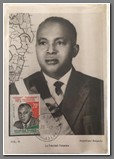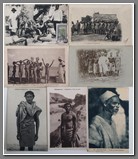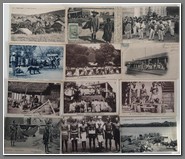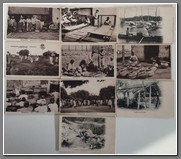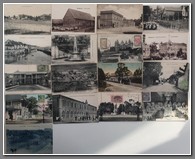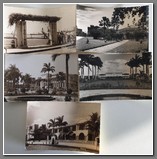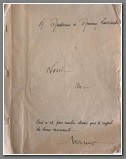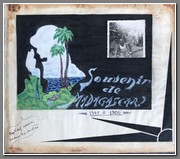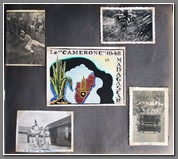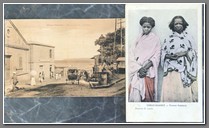Madagascar / Indian Ocean
Interesting photo scrapbook put together in August 1949 by one Francois Lorenzi, resident of Nosi-Be Madagascar in honor of his friend and author L.G. Lucciardi and his wife. 38 photos, with some artwork. What is interesting is the mock legal proceedings documented on the last three pages, where Lorenzi is found guilty and sentenced to buying his friends drink and his punishment if he fails to comply he will receive four blows on the nose. There is Lorenzi’s appeal, which is presided over by Lucciardi, and the results of the appeal. Well captioned. These men were lawyers making fun with each other.
Price: $500.00
Note: L.G. Lorenzi was a lawyer and in 1949 wrote Award given: solemn distribution of prizes, Lycée Gallieni at Antananarivo. In 1956 he wrote La justice en matière de droit local à Madagascar. He went on to become Avocat General at Abijan until 1958.
Photo album belonging to French Foreign Legionnaire Captain Nasoni while serving in Madagascar during the Malagasy Uprising, which lasted from March 1947 to February 1949. He was with the 4th Foreign Legion Demi-Brigade of Morocco (4e DBLEM). Shows troops disembarking at Ambisitra, military camp, Foreign Legion post at Antoetra, a military column in the wilderness, French soldiers parachuting into the military post at Ambofampana, fraternizing with local women, a visit to the island of Reunion, military parade through St. Denis, returning to Madagascar, cyclone damage, military post 332, entrance to the 4e DBLEM camp, in-camp recreation, local Betsileo, local tombs, local villages, albino child, local markets, Antanarivo, fighting in the jungle, armored convoy, parade at Ambositra, REBEL CHIEFS, Majunga, Diego Suarez, Nasoni with a Hova woman, returning home in 1941. Over 300 photos. Anything French Foreign Legion is rare and highly sought after. Similarly, anything on the Malagasy Uprising is rare.
Price: $2500.00
Note from Wikipedia: 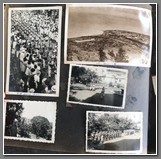 MD 121
MD 121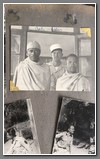 MD 121The Malagasy Uprising was a Malagasy nationalist rebellion against French colonial rule in Madagascar, lasting from March 1947 to February 1949. Starting in late 1945, Madagascar's first French National Assembly deputies, Joseph Raseta, Joseph Ravoahangy and Jacques Rabemananjara of the Mouvement démocratique de la rénovation malgache (MDRM) political party, led an effort to achieve independence for Madagascar through legal channels. The failure of this initiative and the harsh response it drew from the Socialist Ramadier administration radicalized elements of the Malagasy population, including leaders of several militant nationalist secret societies. On the evening of 29 March 1947, coordinated surprise attacks were launched by Malagasy nationalists, armed mainly with spears, against military bases and French-owned plantations in the eastern part of the island concentrated around Moramanga and Manakara. The nationalist cause was rapidly adopted in the south and spread to the central highlands and the capital of Antananarivo by the following month, with the number of Malagasy nationalist fighters estimated at over one million. By May 1947, the French began to counter the nationalists. The French tripled the number of troops on the island to 18,000, primarily by transferring soldiers from French colonies elsewhere in Africa. The colonial authorities sought to fight on the physical and psychological fronts and engaged in a variety of terror tactics designed to demoralize the population. The French military force carried out mass execution, torture, war rape, torching of entire villages, collective punishment and other atrocities such as throwing live Malagasy prisoners out of airplanes (death flights).
MD 121The Malagasy Uprising was a Malagasy nationalist rebellion against French colonial rule in Madagascar, lasting from March 1947 to February 1949. Starting in late 1945, Madagascar's first French National Assembly deputies, Joseph Raseta, Joseph Ravoahangy and Jacques Rabemananjara of the Mouvement démocratique de la rénovation malgache (MDRM) political party, led an effort to achieve independence for Madagascar through legal channels. The failure of this initiative and the harsh response it drew from the Socialist Ramadier administration radicalized elements of the Malagasy population, including leaders of several militant nationalist secret societies. On the evening of 29 March 1947, coordinated surprise attacks were launched by Malagasy nationalists, armed mainly with spears, against military bases and French-owned plantations in the eastern part of the island concentrated around Moramanga and Manakara. The nationalist cause was rapidly adopted in the south and spread to the central highlands and the capital of Antananarivo by the following month, with the number of Malagasy nationalist fighters estimated at over one million. By May 1947, the French began to counter the nationalists. The French tripled the number of troops on the island to 18,000, primarily by transferring soldiers from French colonies elsewhere in Africa. The colonial authorities sought to fight on the physical and psychological fronts and engaged in a variety of terror tactics designed to demoralize the population. The French military force carried out mass execution, torture, war rape, torching of entire villages, collective punishment and other atrocities such as throwing live Malagasy prisoners out of airplanes (death flights). 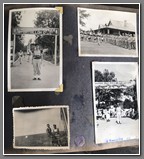 MD 121
MD 121 MD 121The estimated number of Malagasy casualties varies from a low of 11,000 to a high of over 100,000. The nationalists killed approximately 550 French nationals, as well as 1,900 Malagasy auxiliary men of the French army. By August 1948, the majority of the nationalist leaders were killed or captured, and the Uprising was effectively put down by December 1948, though the last armed resistance was only defeated in February 1949.
MD 121The estimated number of Malagasy casualties varies from a low of 11,000 to a high of over 100,000. The nationalists killed approximately 550 French nationals, as well as 1,900 Malagasy auxiliary men of the French army. By August 1948, the majority of the nationalist leaders were killed or captured, and the Uprising was effectively put down by December 1948, though the last armed resistance was only defeated in February 1949.
The violent repression of the nationalist insurgency left deep scars in Malagasy society. A generation of the managerial class was wiped out, creating challenges for the country when it achieved independence in 1960. Madagascar's first three deputies were arrested, tortured and kept in prison until they were given amnesty in 1958. Another leader who survived the conflict, Monja Jaona, was also jailed for nine years and then founded the Madagascar for the Malagasy Party (MONIMA), which has had considerable influence on Malagasy politics. France classified most documents related to the Uprising, and the French government maintained silence on the subject until French president Jacques Chirac termed it "unacceptable" during an official visit to Madagascar in 2005. Several Malagasy directors have set films in the period of the Uprising. In 1967, the Malagasy government declared 29 March an annual holiday, and in 2012, a museum dedicated to the Uprising was inaugurated in Moramanga

